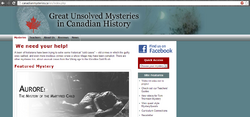CIRCA:Great Unsolved Mysteries in Canadian History
From CIRCA
Contents |
Overview
"We need your help! A team of historians have been trying to solve some historical "cold cases" -- old crimes in which the guilty ones walked, and even more insidious crimes where a whole village may have been complicit." (Great Unsolved Mysteries in Canadian History)
Originally conceived by Ruth Sandwell and John Lutz at the University of Victoria, the project started with the site "Who killed William Robinson?". The site introduced the project's standard format. By assembling and transcribing all the key documents surrounding a historical cold case the site served two purposes: first, to act as a virtual archive; second, to draw students’ interest into Canadian history and archival research with the promise of solving historical cold crimes. The format is less about finding the right answer than improving students’ critical thinking and research skills. Ideally, these skills should include critical reading, critical analysis/thinking, understanding different points of view and the ability to think historically.
In 2003 the project received funding from the Department of Canadian Heritage to create two new mystery archives ("We Do Not Know His Name: Klatsassin and the Chilcotin War" and "Aurore: The Mystery of the Martyred Child"). Since then, additional funding has allowed them to expand into nine other mysteries and their sister site, MysteryQuests, for shorter, age specific mysteries.
Each mystery site has a staff working on it comprised of funders, researchers, technical specialists, instructional specialists, translators, editors and administrators. The mystery's staff and the institutions drawn from are credited in their respective mystery's "About Us" page.
Audience
The primary audience of the project is students as it was designed for educational purposes. Students are put in the position of ‘detective’ in order to entertain and educate them. The site's aim is to make history interesting through a fun premise. By giving students the context and documents available to historians, it not only engages them with the raw material but it encourages them to make and defend their own interpreted histories.
The site operates on four main levels but the level to which teachers push students depends on their skills. The first two levels - first, Reading and Understanding Primary Documents; second, Exploring the Social History of Canadian Society - are accessible to grade school and junior high students. Level three-Doing History, is aimed at junior-undergrad students and four (What is History and How Can We Know It?) is aimed at senior-undergrads and grad students.
The project provides extensive materials for teachers to adapt the site's materials. Materials range from teachers guides, activities and briefing sheets, discussions, summaries of foundational ideas behind the site, pre-made advertisements, and passwords to the historians' interpretations sections.
Analysis
As an educational tool the project has proved effective and its work has been lauded. Since its creation, the project has won numerous honours, awards, and recommendations and has been reviewed by organizations, journals, and teachers' organizations. The project also continues to expand with class implementation, workshops, presentations, a free electronic newsletter, and social media.
However, as a virtual archive the project is lacking. Though original texts have been made available through transcription the information has been simplified for educational entertainment. Some of the transcriptions are incomplete or even altered slightly to fit the transcriber's interpretation, leaving the task of finding the original unedited documents to the viewer. Even looking for information within the site's available sources is difficult, as they are sorted primarily according to 'clue units'.
Limited accessibility has also privileged information to teachers or eligible others. Each site is accessible and the site's sources are listed but potentially useful information is locked to teacher logins. In order to view the historians' interpretation sections or support materials (teachers’ guides, evaluations, briefing sheets...) a viewer must submit a request to the project staff. The request form asks for specific information and they may choose to verify with the viewer's school or organization. For project staff and teachers these steps could be useful. The project's staff uses the information to get a feel for the range of courses and teachers using the site and the teachers may be notified of major changes in the sites or passwords. For other users, for educational or entertainment or alternative purposes, it is limiting.
External Links
Great Unsolved Mysteries in Canadian History Website
Great Unsolved Mysteries in Canadian History: Mystery Quests Website

